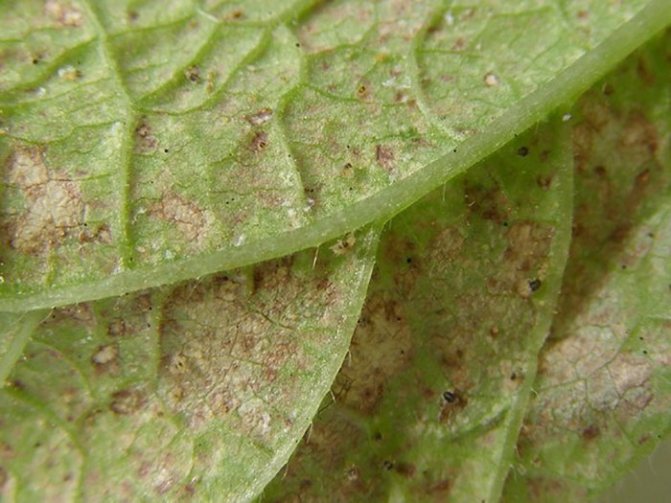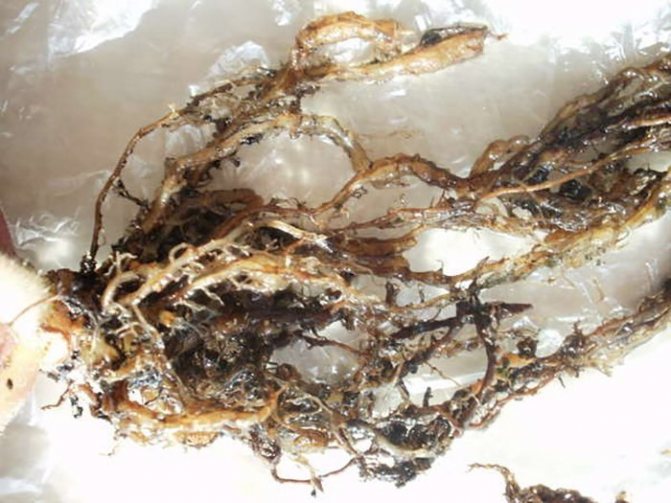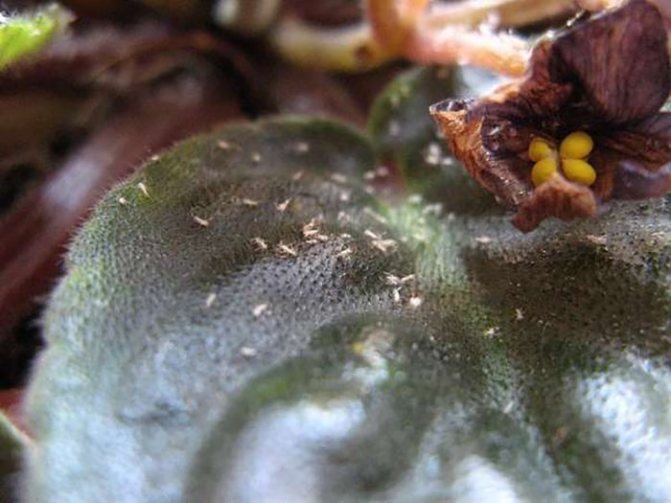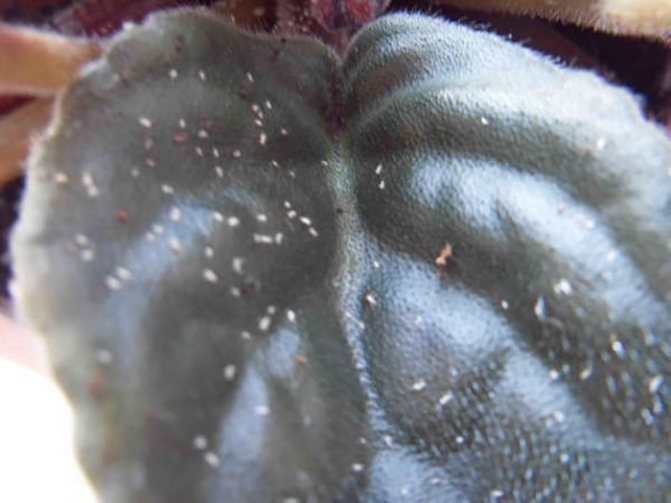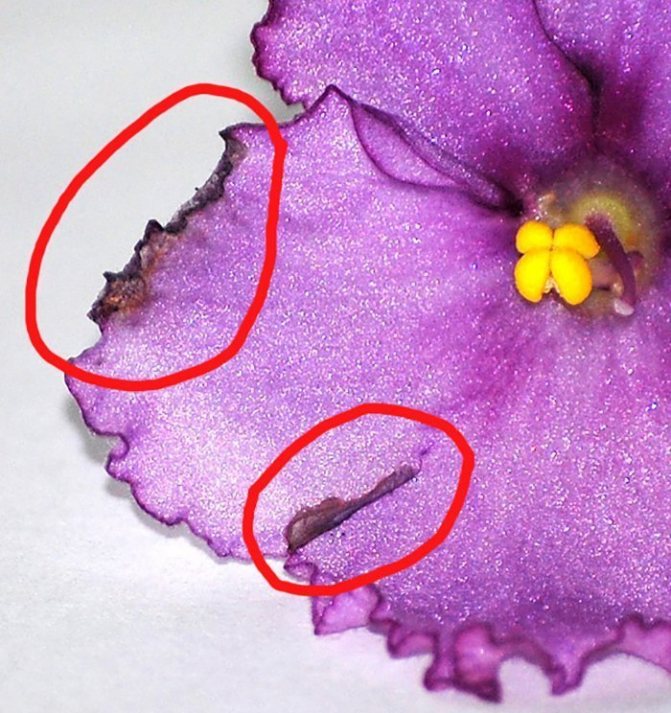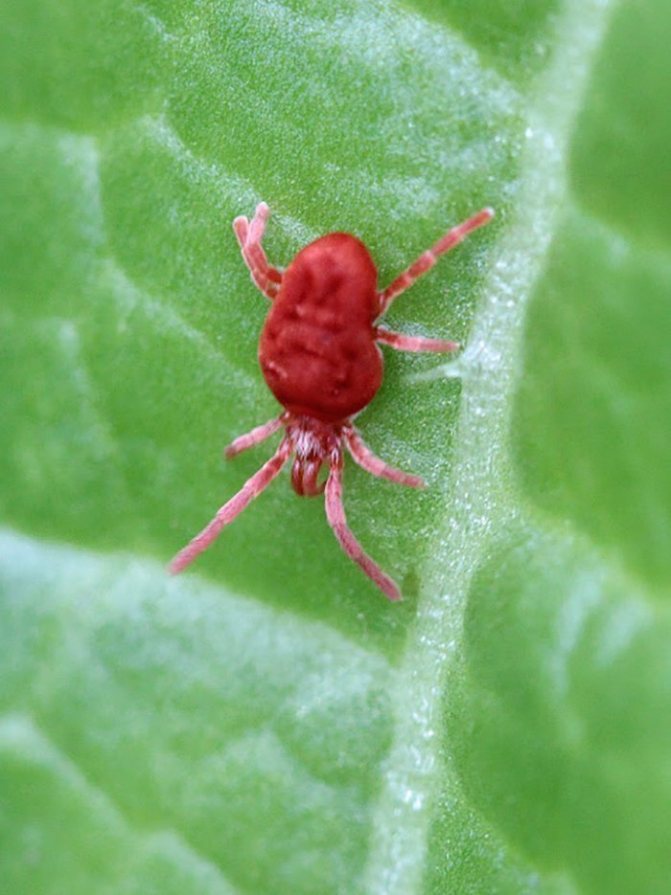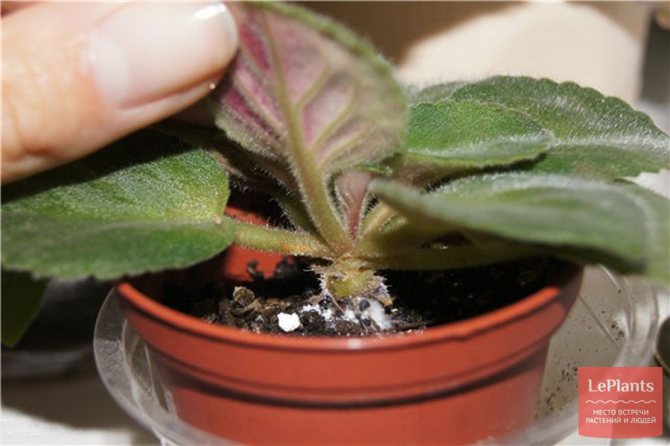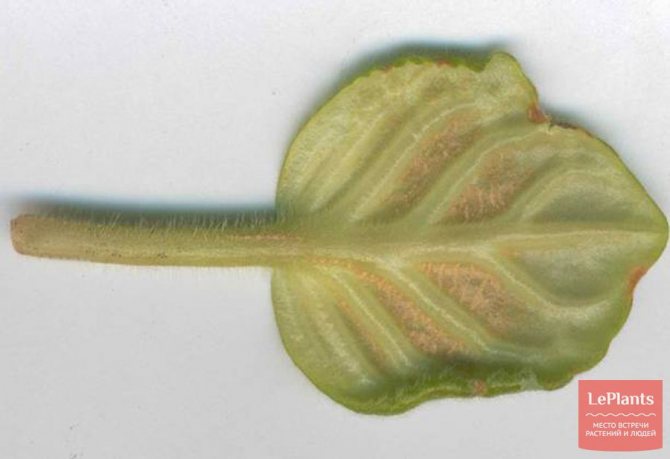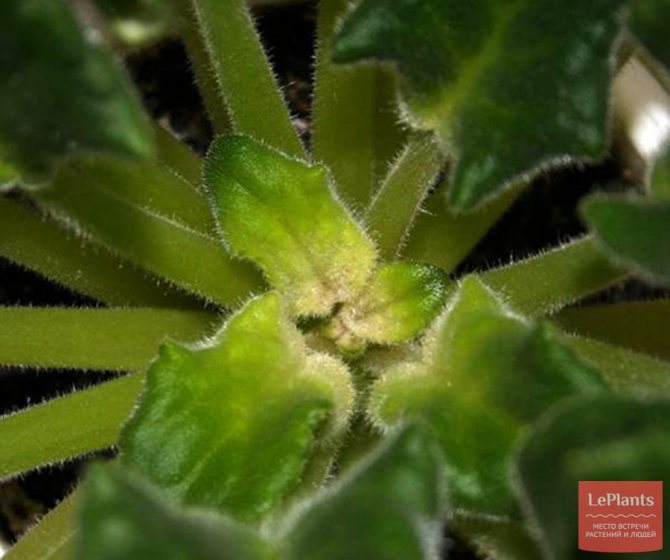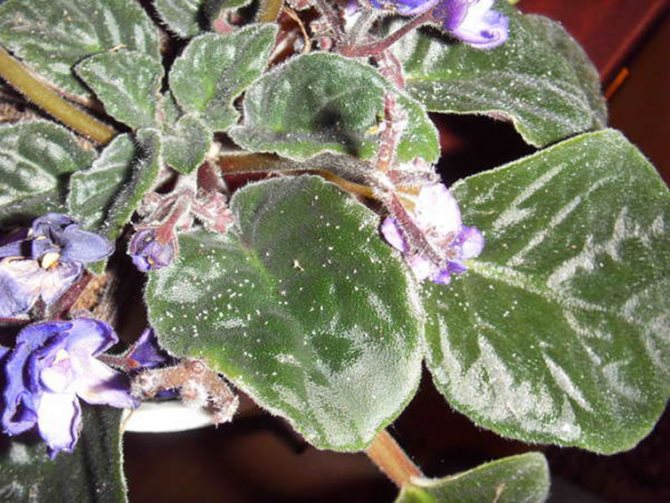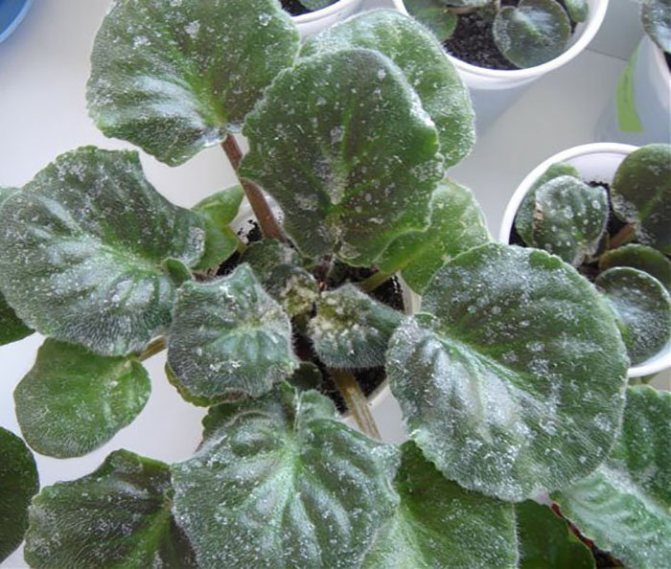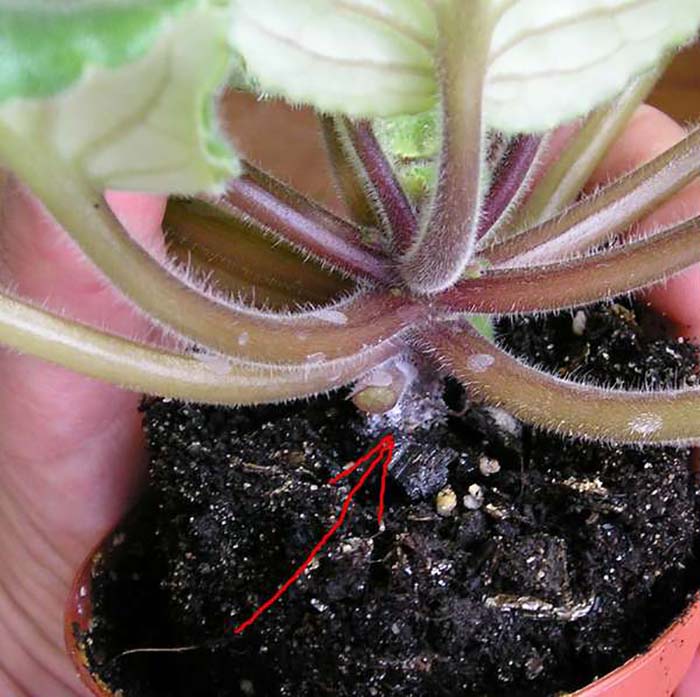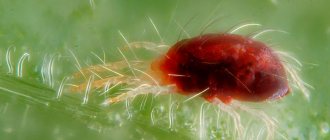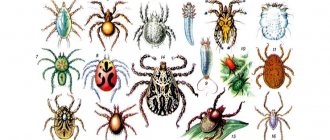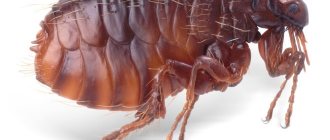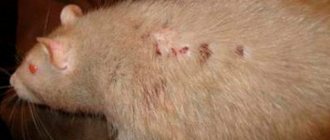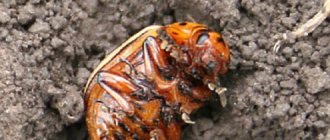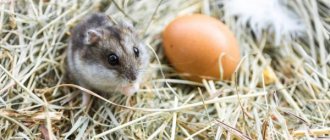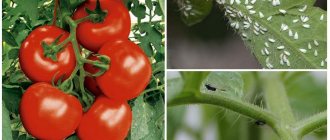The mite on violets is a big problem for those who love these flowers. This parasite is a fairly common pest. It can affect different parts of the plant. The tick drinks juice from the leaves, so that metabolic processes are gradually disrupted, due to which the plant then dies.

Description and appearance
Most often, a cyclamen mite appears on violets, which also affects other indoor plants. Azalea, Kalanchoe, cyclamen are most at risk of infection. But these pests harm not only indoor flowers, they affect garden and horticultural crops. They have very small body sizes and it is simply impossible to see them on a flower without magnifying devices. They belong to the arachnids.
They have a translucent, oblong body, light yellow, 8 legs. They live in buds and on young shoots. Their diet consists of plant sap. These pests multiply very quickly and colonies grow significantly within a few days after infection.
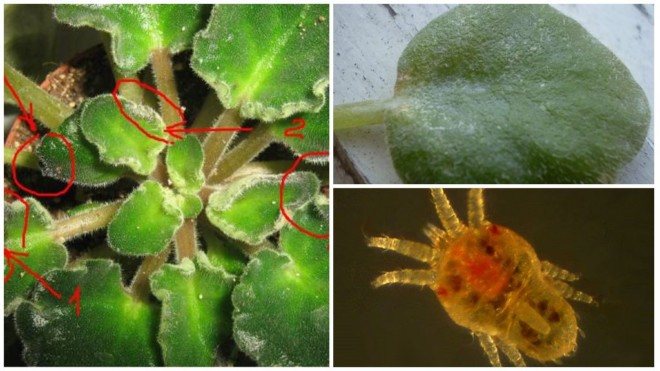

One female lays 12 to 16 eggs daily, which takes only 3-7 days to develop. A week after laying the eggs, young individuals appear that need nutrition and are ready for further reproduction. You can see how they look in the photo.
Favorable conditions that contribute to their rapid reproduction are warmth and minimum humidity. Therefore, the peak of their activity for indoor plants occurs in the winter, when the apartments have heating. And for garden crops, such a favorable environment occurs in the summer, when hot and dry days come.
Pest prevention
Preventive measures against the appearance of ticks are more effective than controlling these pests. Compliance with simple rules for keeping violets will help them stay strong, healthy and delight with their beauty. You must adhere to the following rules:
- a new, just bought flower should be placed separately from others, in quarantine;
- remove fallen flowers, rotten and yellowing leaves;
- create optimal conditions for life and flowering (appropriate light and temperature conditions, timely irrigation, fertilization), it is imperative to bathe a flower in hot and dry weather;
- do not put pots with violets very close to each other;
- you do not need to bring flowers cut into bouquets or grow roses into a room with saintpaulias, because they are more likely to contain parasites.
The number of pests grows with lightning speed when hot and dry environmental conditions are created. Then it is better to bathe violets in warm running water. Adhering to optimal climatic indicators (air temperature from 22 to 18 degrees and normal humidity), the activity of ticks decreases, they stop multiplying.
Ticks are a great danger to Saintpaulias, so you need to immediately take measures to destroy them as soon as there is a suspicion of their infection of plants. Timely treatment for these parasites will keep these delicate beautiful flowers healthy and alive.
It is also useful to read: Treatment of an area from ticks
Signs of defeat
Since it is impossible to discern the pest on the violet, the infection can be understood from the external signs that appear on the flower.On young shoots, buds, as well as young green leaves, something like a dusty coating appears. On the leaves, tick infestation is most noticeable, since they change their color, fade, a yellow tint appears, then they turn brown-gray and the leaves are deformed.
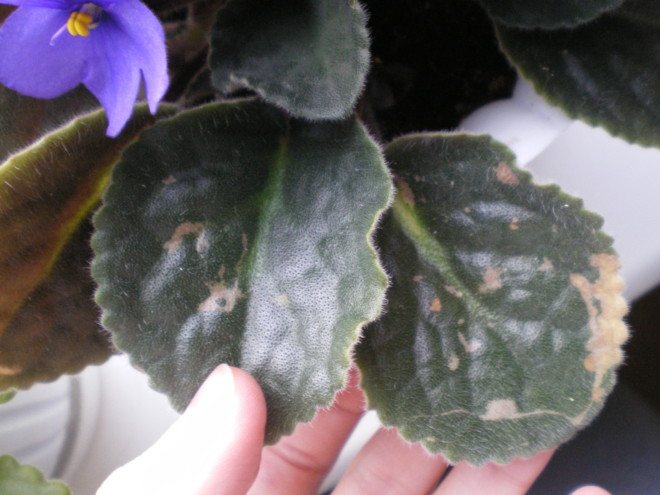

Petioles and leaves become very dry and brittle. Also, on young leaves, thin hairs similar to a cobweb appear. The buds do not open and begin to fall off.
If such signs are found, it is necessary to resettle the infected flower so that the pests do not attack neighboring flowers. You will need to immediately resort to treatment methods.
Treatment schemes for the destruction of ticks on violets
To shorten the period of hatching of larvae from eggs and reduce the period of their development, it is required to maintain the air temperature at a level above 20 ° C. The best option is 25 ° C. And this also applies to night time. Now you can act according to several schemes.
Here are the most popular ones:
- The first scheme. This option is perfect for apartments, houses and other residential buildings. Acaricidal preparations Sunmayt, Nissoran, any other means from the category of avermectins (for example, Vetimek, Akarin, Aktofit, Fitoverm) are used. First you need to process the leaves with Sunmight until they are completely wet. You will need 1 g of the substance per 1 liter of water. This tool kills all forms of ticks, and not only adults, but also larvae and eggs. But, despite the high efficiency of Sunmight, it is recommended to repeat the treatment with Nissoran after 5 days. You will need to dilute 0.5 g per 1 liter of water. In parallel, use avermectins at a rate of 10 ml per 1 liter. It is better not to apply Sunmight again so that the pest does not get used to it.
- Second scheme. This option is also recommended for residential buildings. You will need Sunmight and Judo (Oberon). First you need to treat it with Sunmight (1 g of product per 1 liter of water). Then, after 5 days, carry out the procedure again, but use the second drug at a rate of 0.3 ml per 1 liter of water.
- Third scheme. This option is also suitable for living rooms. This scheme is used in the event that it was not possible to purchase Sunmight. You will need drugs from the avermectin group, as well as Envidor, Oberon, Nissoran. It is necessary to mix avermectin with another of the listed products. Consumption rates are described above. Then spray it twice (the second is required 5 days after the first procedure).
- Fourth scheme. This option is used only in non-residential enclosed spaces. Actellik is used. It has fumigating properties, that is, it evaporates quickly and actively. That is why a good sealing of the room where the violets are located is necessary. And you will have to wait a week. It is recommended to pack the plants in a plastic bag if the number is small. For a large collection, it is best to seal the room - seal all openings, ventilation passages, doors, windows. You will need to apply Actellic at a rate of 3 ml per 1 liter of liquid. By the way, the processing may not be thorough. The product will evaporate, and that's enough to kill even hidden pests.
- Fifth scheme. This option is considered very simple, but also the most dangerous. It is strictly forbidden to use such a scheme in living rooms. Marshal is used - an insecticide of a systemic type with a pronounced acaricidal and nematicidal effect. The main active ingredient of the product is carbosulfan. It is necessary to dilute the substance in 3 ml per 1 liter of water. Spraying is shallow. Processing can be carried out not thoroughly, since the substance is quickly absorbed into the plant, and then spreads to its other tissues.
Control methods
There are many ways to combat this microscopic pest. You can use specialized chemicals or seek help from folk methods.
Folk methods
The most effective methods include bathing the violet at a specific water temperature. The procedure is as follows, at the first stage it will be necessary to remove strongly affected leaves. Next, take a container and pour water at a temperature of 45 ° C into it. A thermometer will be required, since this method is effective precisely at such a temperature, if it is higher, then you can harm the plant, and if it is insufficient, then the procedure will not bring any effect.
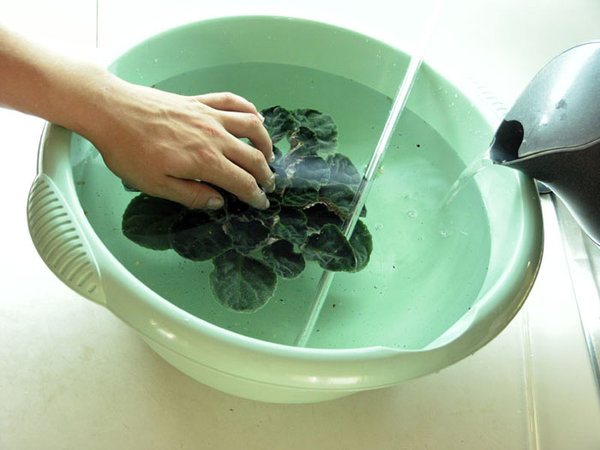

Next, you need to immerse the flower completely in water for 15 minutes. The correct temperature must also be maintained during the procedure. After the water procedure, it must be placed in a shaded place, and after a few days it can be returned to its original place.
Chemicals
As in the case of folk methods, the mandatory step is to remove the affected parts. Most often, acaricidal agents are used for processing, with which it is necessary to wipe violet leaves. These include Akarin, Fitoverm, Aktofit, and others. Rubbing is carried out every 3 days, then the time intervals are increased to 5. When the bush is very infected, then they do not use rubbing, but bathing, when the flower is completely immersed in the solution.


If we talk about insecticides, then they are ineffective against pests. All for the reason that mites develop immunity to active ingredients, in addition, the funds are not able to destroy egg clutches. When carrying out treatments with acaricides, it is necessary to carry out several procedures in which the funds are changed.
Anti-mite, Omite, Kleschevit, Neoron show quite good efficiency. But remember, processing with these tools should not be carried out in an apartment. After the procedure, the violet is covered with plastic wrap for up to 24 hours. The drugs are toxic and when using them, protective equipment must be used.
Folk remedies, if you do not want to resort to chemistry
Many people prefer folk remedies for pest control, not wanting to use chemicals. These remedies are less effective, but when used correctly and regularly, they also show a good effect.
It is necessary to collect all detected insects using a gauze or cotton swab soaked in a strong solution of laundry soap (one part of the soap dissolves in 6 parts of water). Thoroughly wipe the entire surface of the leaves and branches of the plant with this solution. At the end of the treatment, the solution is not washed off.
Alcoholic treatment of plants is also quite effective. For these purposes, exclusively pure alcohol should be used, which evaporates as quickly as possible from the surface of the plants. Alcohol is contraindicated in plants with delicate and pubescent leaves.
One of the most popular folk methods is the processing of plants with tobacco tincture. To prepare it, you need to take 1 part of terry for 10 parts of hot water. The tincture should stand for two days, after which it is boiled for two hours, cooled and filtered.
Before use, the composition should be diluted with water in a 1: 2 ratio, add 10 grams of laundry soap per 1 liter of solution. It should be noted that the tobacco solution in such a high concentration is toxic to humans and pets.
Aphids on violets grow on all parts of plants, but prefer young leaves for habitation. Insects are small in size - about 2 mm. They can be easily removed and crushed by hand if the affected area is not too large.
Aphids reproduce catastrophically: every 2 weeks, 1 female lays up to 150 eggs. Therefore, measures to combat parasites must be taken immediately.
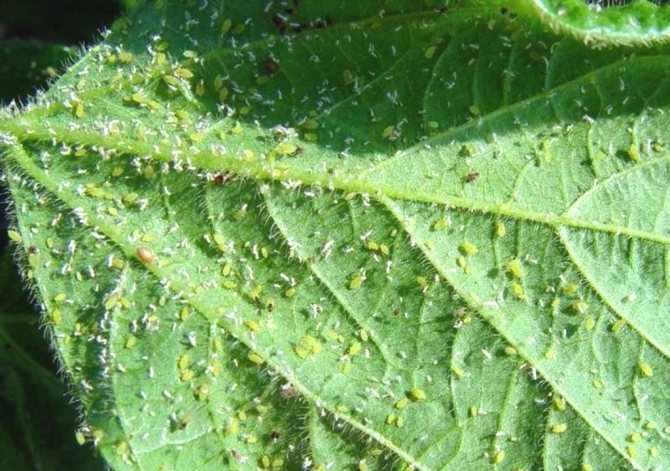

Security measures
It is imperative that when using chemicals, you need to wear rubber gloves, a respirator and clothing that covers the body. The processing does not use containers that are used in the kitchen and when preparing food.
Do not use soap in solutions, as it will significantly reduce the effect of the active ingredients. Treatment solutions should be prepared immediately before use, and residues should be disposed of. It is necessary to carry out the procedure in the open air; when carried out in residential premises, it can harm the health of people and animals.
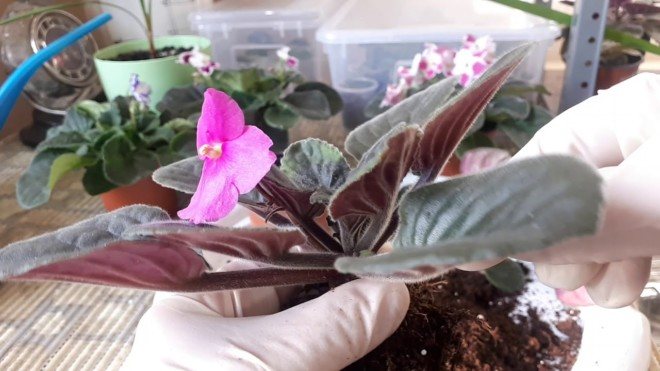

After the treatment has been carried out, the bushes are quarantined, where they will be isolated from other plants. After 3-4 weeks, it is necessary to examine the violet, leaves and young shoots, when no signs of infection are observed, the violet can be returned to other flowers.
Popular remedies for ticks on violets
Nowadays, many medicines have been developed that help get rid of violets from various types of ticks. Here are the most popular ones:
- Preparations from the avermectin group. This includes Aktofit, Akarin, Agravertin, Fitoverm. They need to be diluted to calculate 10 ml per 1 liter of clean water. The same group includes Vertimox, which is diluted in the amount of 1 ml per 1 liter of liquid. If it is not possible to purchase such drugs, then in the veterinary pharmacy you can take insectoacaricides, which are injected under the skin of pets and cattle. Such funds have a concentration of the active ingredient of only 1%, so you need to dilute them with 2 ml per 1 liter of water. But this is only as a last resort.
- Judo. This drug is also called Oberon. The active ingredient is spiromesifene. It is necessary to dilute it at 3 ml per 10 liters of liquid. This preparation has shown excellent results in greenhouses where the mites are already accustomed to other pesticides. The active substance penetrates deeply into the leaf, but does not spread through the vascular system of the violet.
- Envidor.The active substance is spirodiclofen. It is necessary to dilute the product in 6 ml per 10 liters of liquid. The drug has no systemic properties, its action is exclusively contact. It affects individuals at all stages of their development.
- Sunmight. The active ingredient is pyridabene. Taurus is considered the Chinese analogue of Sunmight, it is also suitable for processing. It is used for indoor flowers, including gloxinia, fuchsia, streptocarpus, Saintpaulia. You need to dilute 10 g per 10 liters of water. It is allowed to process such preparations only 1 time, and it is better to choose another agent for secondary disinfection.
- Nissoran. The active ingredient is hexythiazox. It must be diluted 5 g per 10 l of water (maximum dosage - 8 g). It has an ovicidal effect, so it will quickly destroy both larvae and eggs of parasites. Human toxicity is low. The agent does not evaporate. Compatible with almost all agricultural products. Very persistent.
- Masai, Piranika. The active ingredient is tebufenpyrad. Belongs to the category of pyrazoles. Has contact and intestinal effects. It is necessary to dilute with 0.4 g per 10 liters of water. It is allowed to increase the dosage up to 1 g.
- Ortus, Kiron. The active ingredient is fenpiroximate. Also belongs to the category of pyrazoles. It is necessary to dilute only 0.02 g per 1 liter of water. The maximum dosage is 0.2 g. The action is contact.
- Marshal. The active ingredient is carbosulfan. This product may only be used in non-residential areas, greenhouses and outdoors. A one-time treatment will be enough. It is required to dilute 3 ml of substance per 1 liter of liquid. The product is a pro-insecticide. In other words, it penetrates into parts of the plant, and then breaks down into very strong poisonous compounds.
- Actellic. The active ingredient is pirimifosmethyl. It is necessary to dilute 3 ml per 1 liter of water. It is allowed to use only in closed non-residential premises. It is considered very poisonous.
Other types of ticks
- Unfortunately, not only the cyclamen mite is dangerous for violets, plants can also infect other types of mites. One of them is spiderweb, which is no less dangerous and can lead to the death of a violet.These are small parasites that reach no more than 1 mm. In the warm season, they have a green calf color, and in autumn and spring they change it to red.
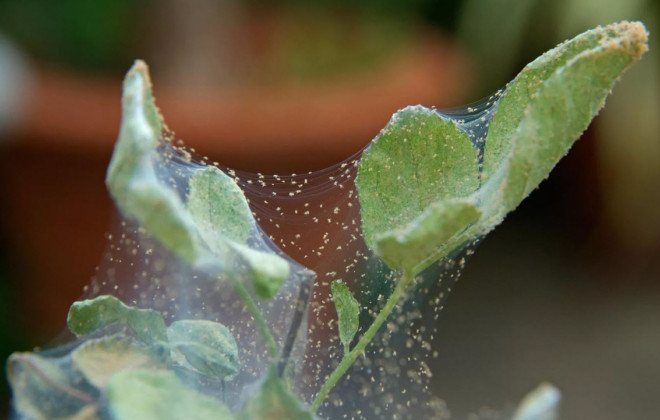

- It is dangerous not only for violets, it affects the pest of berry and fruit crops. They also feed on plant sap. The product of their vital activity is the cobweb that envelops the flower, and it is possible to determine the infection from it. In the fight against it, acaricides and folk remedies are quite effective.
- Another dangerous species is the flat heifer, this tick affects violets, cacti, ficuses, citrus fruits and other types of indoor plants. It has an ovoid body shape and can be yellow-orange or yellow-brown in color. When infected, the leaves begin to dry, the plant weakens and dies. Favorable conditions for breeding are temperatures of 18-24 ° C, so they lay eggs all year round, which is a great danger. In the fight against them, acaricidal agents are used.
- Do not bypass the violet and root mites, as they are also called bulbous. They infect the plant underground, most often orchids, gladioli, tulips, etc. are attacked by these pests. High humidity serves as favorable conditions for their reproduction. It is necessary to store bulbs only in dry rooms where the humidity level does not exceed 60%, which is an effective prevention.
General information
Family members Tenuipalpidae (flat mites) are close relatives of spider mites, for which they are sometimes called false spider mites... The main anatomical difference between these groups is that in spider mites the body is whole, while in flat mites it is divided by transverse sutures into several parts (anterior, middle and posterior).
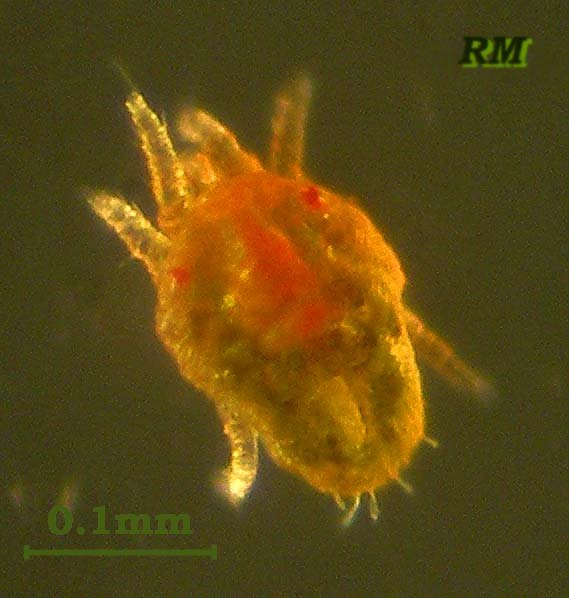

Larva of flat beetle Brevipalpus obovatus
Florists meet with representatives of two genera of flat mites - with Brevipalpus and tenpalpus (Tenuipalpus). Brevipalpus russilus (= Hystripalpus russilus, = Tenuipalpus cactorum) - the cactus flat heifer is a dangerous pest of cacti. Tenuipalpus pacificus severely damages orchids and ferns. He is sometimes called phalaenopsis tick... Orchid pests are also oncidium flat tick (Brevipalpus oncidii) and greenhouse flat beetle (Brevipalpus obovatus)... Various representatives of flat mites (the most famous, about 40) harm grapes, citrus fruits, palms, unabi, privet, ivy, milkweed, rosaceae, ficuses and many other tropical and subtropical plants. The exact identification of pests of this group is extremely difficult. There is no definitive literature available and there is no consensus on the taxonomy of these ticks.
We will talk in detail about greenhouse flat beetle - Brevipalpus obovatus, because it is she who damages the violet and other Gesneriaceae. In Russian-language sources, this species can be called greenhouse flat beetle, common flat beetle, red flat mite, orange flat mite and etc.


Male flat calf Brevipalpus obovatus
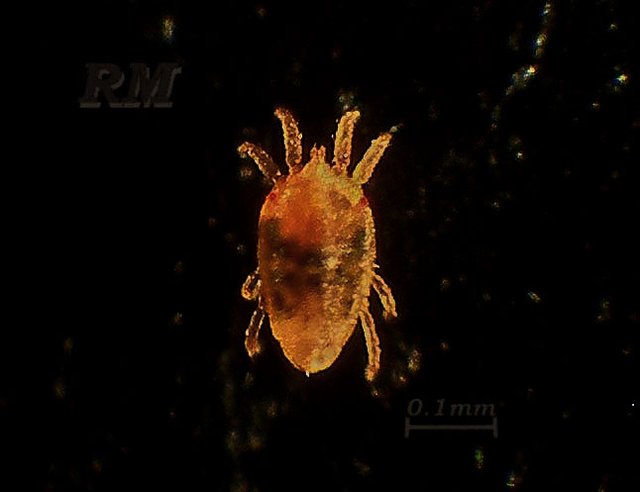

Female flat calf Brevipalpus obovatus
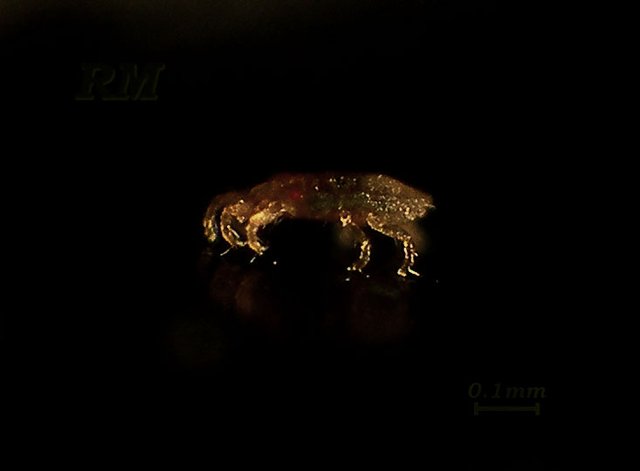

Squat Brevipalpus obovatus - side view
Preventive actions
- Of course, the main preventive action is proper plant care. This includes feeding, watering, maintaining the correct temperature and illumination. Most often, infection occurs on bushes that are weakened and do not receive the necessary care, but healthy bushes are equally vulnerable to pests.
- In order to avoid difficult situations, experts recommend regular bathing of plants. This should be done at a time when there is a peak of activity, namely dry and hot weather. In addition, it is recommended for this period to rearrange the bushes to other places so that they do not coexist with other plants.
- Bathing is carried out as follows. The procedure can only be performed under running water. When using a basin or bucket, pests enter the water and re-infestation occurs. While holding the bush, it is necessary to rinse the lower parts of each leaf.
- It is allowed to wipe the leaves under water only with a finger, the use of sponges and rags will contribute to the spread of the pest throughout the bush. Avoid spilling water into the pot, flowers, and the center of the outlet.Water with a temperature of 40 ° C is used, but during the flowering period the temperature is reduced, the water should be slightly warm.
- Water treatments are not carried out in winter if there is no heating. When rotten leaves are visible on the plant, the procedure is not carried out. When the procedure is carried out, using a regular napkin, it is necessary to remove moisture from the leaves.
How to fight at home?
The effectiveness of the measures depends on the timeliness of the treatment carried out and the scale of the infection. It is important to carefully and regularly inspect crops in order to begin to fight at the first sign of pests.


Control methods are selected taking into account the growing conditions for violets. Some chemicals are not suitable for indoor flowers due to their high toxicity, which is dangerous for people in a confined space. At the initial stage or as a preventive measure, folk remedies will help, but they will be powerless in the spread of pests. Considering that aphids are extremely fertile, when they appear on violets, there is a real threat to other plants in the garden or on the common windowsill in the room.
More details on how to deal with aphids on violets at home.
Mechanical removal
If pests are found, and the infestation has not yet become widespread, aphids can be removed mechanically:
- insects are collected by hand;
- the affected shoots break off;
- for indoor flowers - the leaves are washed with warm soapy water, the plant is dried in a warm place.
When the aphids are removed, the plant and the surrounding soil are treated using special means.
An alternative way to remove pests is to attract the natural enemies of aphids. This insect is present in the diet of ladybirds, hoverflies, some species of wasps, birds. Planted fruit bushes, spicy varieties of herbs will help the gardener to attract them.
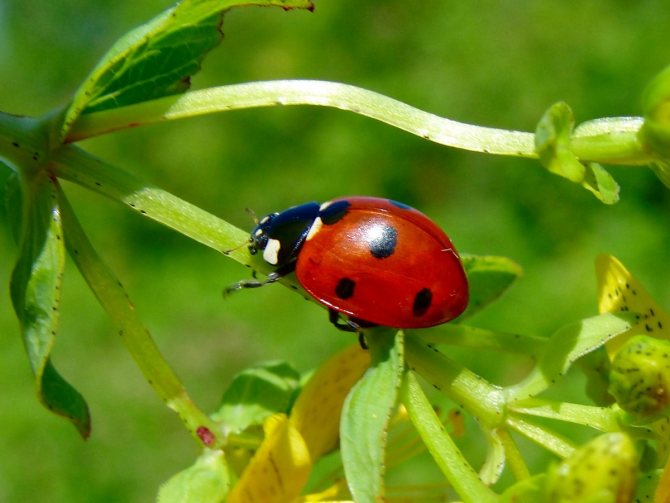

Use of biologics
The means offered by modern industry for the control and prevention of the appearance of aphids are divided into two groups:
- biological complexes - preparations created on the basis of natural components that repel and destroy pests;
- chemical compounds - artificial insecticides.
The main advantage of biological products is low toxicity, no harm to humans and domestic animals. The following biological agents are on sale:
- Fitoverm - acts in an intestinal contact way. In addition to aphids, it destroys other pests. The drug paralyzes insects, penetrating through the protective chitinous coating and with the juice of the treated plant. After eight hours, the pests die if indoor violets are processed. When processing a plant outdoors, it takes twice as long for the full effect of the drug. The tool is available in ampoules of two, four or five milliliters, in vials. Together with the flower, the adjacent soil is processed. After treatment, the agent works for two weeks. To fix the result, after the specified period, re-spraying will be required;
- Aktofit is a drug related to the previous one, created on the basis of a similar active substance. After treatment, the aphid loses its ability to feed after eight to twelve hours. The peak of effectiveness is reached after a week. Two treatments per season are enough to fully protect the plants. Produced in bottles and cans;
- Akarin is a related remedy with a similar mode of action. Diluted at the rate of two to three milliliters of the drug per liter of water. Violets and the soil under them are sprayed with the drug. After a couple of days, the insects completely die.Re-treatment after two weeks is necessary to destroy the pests that hatched from the larvae during the specified period;
- Arrivo is a biological preparation based on a different substance, but with a similar mode of action and conditions of use. It is produced in ampoules of one and a half milliliters, diluted in a bucket of water. The protection period of the treated plants is up to fourteen days.
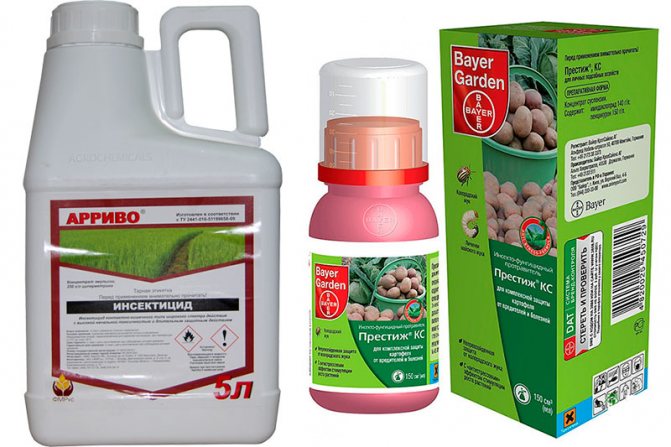

Biological products decompose quickly without causing environmental damage to the environment. When using most of the described products, there is a slight danger to bees for 24 hours after spraying.
Folk methods
If the degree of infection has not yet reached alarming proportions, insects can be scared off with compositions prepared on the basis of folk recipes. These funds will help gardeners who grow indoor flowers if chemical or biological products are not available for sale during the winter season.
The described compositions can be made at home; So, what will help from aphids on violets, scare away pests:
- onion infusion - one hundred grams of onions is finely crumbled and poured with a liter of water. The product is infused for about eight hours in the dark and filtered. At least three treatments are carried out, every two days;
- garlic infusion - a similar amount of peeled and chopped garlic is mixed with fifteen grams of grated laundry soap. The mixture is infused in three liters of water for about two hours, filtered. The bushes are sprayed regularly until the expected result;
- garlic with tomato tops - tomato stems with foliage are crushed, squeezed garlic (up to two teaspoons), a liter of water are added. It is applied after straining;
- celandine - dried and fresh herb is used. Three hundred grams of fresh flowers or one hundred - dried are poured with one liter of water. The composition is kept for up to thirty-six hours, boiled and filtered. The resulting agent is sprayed with infected bushes of violets;
- tar soap - forty grams are ground and dissolved in four liters of water. The composition repels and destroys insects;
- wood ash - sifted powder in the amount of three hundred grams is poured with a liter of water and kept on low heat for up to half an hour. For processing, the concentrate is diluted in five liters of water and used cooled down.


In order for folk remedies to act with greater efficiency, it is necessary to alternate the recipes used, depending on the reaction of the pests.
Chemicals
Modern industry produces effective selective chemical insecticides that eliminate aphids and other pests. These complexes work in three ways:
- intestinal - assimilated by the insect's body and poisoning it;
- contact - penetrating through the protective coating. More often, drugs are produced with a combined - intestinal action;
- systemically - accumulating in plant cells and treated soil.
The most famous drugs that can cure violets from aphid infestation:
- Inta-vir is a synthetic analogue of a plant insecticide. It is produced in powders and tablets, soluble in water and used by aerosol method. Aphids die three days after application;
- Tanrek is a systemic drug that suppresses the nervous system and kills insects, including larvae. To achieve the effect, a few hours are enough, the complete destruction of the infection occurs within a day;
- Bankol is an enteric-contact insecticide. Three grams of the product are dissolved in five liters of water to form a suspension, which is sprayed with flowers.
Chemicals affect aphids much more strongly than other compounds. But their use requires caution. Such drugs are more toxic than biological formulations and require fewer treatments.
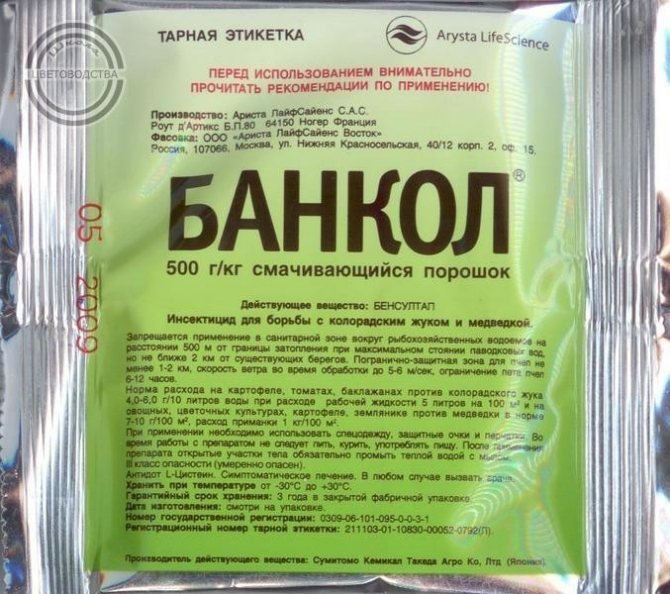

Reasons for infection
Exists several ways of infection:
- Infection from new plants;
- Through open windows, doors;
- On a person's clothes.
It should be remembered that usually weakened plants are attacked by pests, which are not properly cared for.
Incorrect containment conditions
Very often, flower growers themselves create favorable conditions for the appearance of a pest. On a healthy plant with a hard cover and a developed stem, the pest will settle last.
The room must be ventilated and have a certain humidity and air temperature.
Violet that systematically "Overfed" with fertilizers, most likely to be infected. Since she gained weight, but had not yet had time to get stronger.
Weakened by disease Saintpaulia can also be infested with aphids.
From other plants
In the summer, when aphid activity is the highest, the risk of infecting indoor plants is very high. Due to the fact that the windows in the room are opened often, the winged individual can get on the leaves of the violet.
Availability nearby untreated garden plots, increases the risk of infection. Place mosquito nets to prevent winged species from moving.
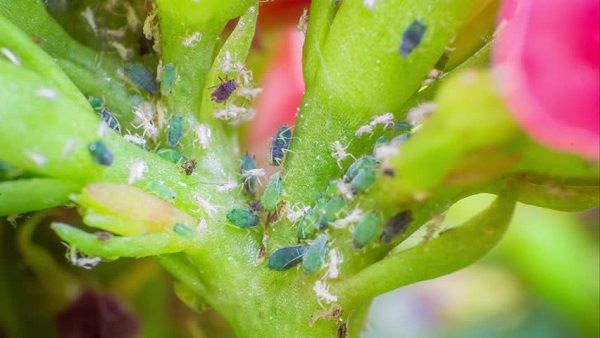

Aphids can be brought along with a bouquet of wildflowers.
INTERESTING! Ants appear in symbiosis with aphids. Therefore, after getting rid of some pests, do not forget about others.
Newly acquired plants or specimens returned from the dacha must quarantine... When bringing bouquets from the street to the house, be careful, with them a female aphid could get into the room.

